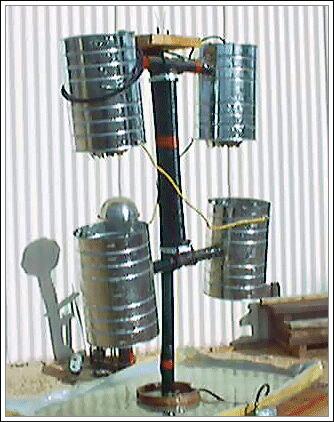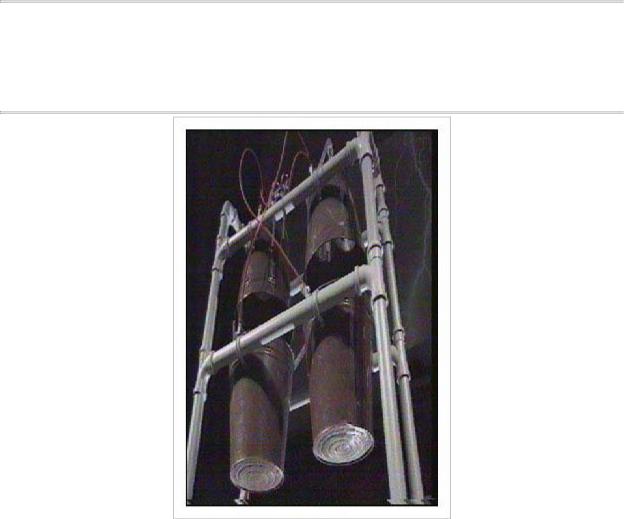
Ebooki / kelvin_generator
.pdf
Lord Kelvin water drop electrostatic generator
Please note:
Some people have reported to me difficulties in getting this device to work.
You need to have some good clean fresh water for this thing to work,
I tried normal rainwater stored in plastic tank here and it did not work either. I charged this water up using a van de graf generator and the dripper then worked as described although not well.
I think water from a reservour supply may not work as well as it sits in a storage area and in metal pipes and with this subjected to chlorine and flouride and with the ambient heat to keep
it drinkable although nature lovers would consider this water dead.
I may be wrong but if you can get some pure clean mountain or running spring water you may be more successful.
if the water is chilled to 4 degree celsius this may also help as water seems to lose something when heated by the hot sun when out in the open
The best water it seem to be something stored in darkness and kept chilled if you are to believe followers of Viktor Schauberger
If you used poly pipe this stuff when it gets damp will conduct electricty away from the cans and I suggest you varnish all the plastic of it using a natural vanish not the petrol chemical version or use a better supporting material.
Wood restorers or hardware suppliers may be the source to try.
The water also has to drip and not be a continous stream but a drip by drip operation. If the air is moist around the device such as high humidity or rain in the air ,it will not work also as the charge will not be allowed to build up due to the water conducting the charge
into the surrounding enviroment.
It should however work great if you have a thunderstorm , A good dry environment is what you are seeking.
We also found that if you lightly greased the grey plastic pipework with silicon grease or similar, the effect was a much inproved spark gap & faster spark repetition.
This seems to prevent water build up on the pipework which we found affected charge build up.
Under no circumstances get any kind of detergent such as washing up liquid anywhere near it, as this kills the charge build up immediately!
Hope this helps. Please let us know how you & everyone else get on.
In the late 19 th century and early 20 th century there was performed a nearly forgotten experiment that generated static electricity. by lord Kelvin as shown in the photograph below.

These following examples are a modified form that will give better results.
The frame work is made of PVC tubing that holds 4 x 1.5kg empty coffee tin cans or anything made of metal.
This is a diagram of the basic setup of the unit.
Notice the criss cross wiring of the cans this is same for all units shown.
The red conductive lead are crossed on the front of the unit.and an electrical conductive pathway is made between the two cans.

The black leads are connected on the back of the unit in an opposite manner.
The black lead and the red leads then are joined to the seperate sides of a spark gap.
A small pump recycles water from the bottom to the two sprinkers above the two top cans and then sprayed into the top cans and then drips by means of gravity into the cans below.
The water then drips into a collection tray below and is then again pumped up agaian.
The water carries electrons from one can to another and acts as a voltage doubling circuit building up voltage levels until a discharge occurs at the spark gap.
The Authors own version mk1
The top of the upper two tins will contain small plastic micro garden sprinklers popularly used and very cheap.
Both of the bottoms of the uppermost cans have about a two inch centre hole to allow water to drip into can below..
The two bottom cans have there tops completely removed and small holes punched in the bottom of each can to allow water to drip into a common collection tray.

Water is pumped through the plastic tube from the collection tray via a small car windscreen water pump and sent to the two sprinklers mounted in the lids and then the water drips through the can until it reaches the collection tray.
distance between top and bottom can should be such that water drips and is not a continuous flow.
Wire leads are connected to di-anglar cans and then to a spark gap terminal
When water is flowing a spark should be generated every twenty seconds experimentation will be needed to adjust the spark gap for better results.
Below are several photographs of a version using 4 buckets connected in a criss cross way as described and shown on A British TV education program.
This Generator produced from household drainpipes etc as pictured above was designed & built by Mr M Hill of the Physics Department, University of York, England. The Generator is alive & well & continuing to give pleasure & amazement to the general public.
A view from the bottom looking up wards

You are unable to see it but there are holes placed in the bottom buckets.
A view looking from the front with water flowing and pumped through the unit from the bottom collecting surface and returned to funnels placed above the buckets.

The water delivery from funnels at top of unit

How charges are distribruted on the four buckets that are cross connected.
Each of the top buckets is connected toa metal ball surface and at discharge distance. In this unit a charge is discharged at every 20 seconds.
Greater results may be be obtained if you add more crossover stages.
Below the author's attempts to make a similar device as to the one shown above. I believe my latest version is much better than my first unit.

side view of web authors unit
back view of web authors unit
front view of author's unit notice the brass door knobs used as a spark gap.
The unit is made using PVC irrigation piping 3/4" in diameter
Construction is made using plastic pipe lengths cut to the same length and with four angle joiners and 12-18 T connectors depending on your construction choice. The drums were made from some offset used aluminium sheeting cut to size as I found it easier to bend than other metal I had at hand.
I think any available metal should be okay to use.
The angle to cut the metal sheeting is important and you should end up have the shape of a bucket when the two ends are joined together.
I cut up a used cardboard chip cup or you can also use a take away drink container cut down one side to get the right angle to the metal you desired to use. although you will need to size up the cut out to make larger containers.
I traced the shape out on some cardboard and gradually increased the size until I finally got the size I wanted and used it as a template to draw on the metal I needed to cut.
I used gaffer tape when joining the two ends of the flat metal cut so as to form the bucket shape. Please note,If you use one piece it will not form a bucket shape.
But I have found if you put three pieces together one inside the other the shape naturally resulting will be the correct bucket shape.
So you will need to cut twelve pieces of metal out to make the four cups or buckets as shown in photos above.
The bucket is then put together with some plastic gaffer tape and when a new insert is added I put some contact glue on the metal to help make it more rigid and glue the sperate pieces together.
When I put the bucket shape together I inserted some metal fly door screening in bottom of bucket btween the the first and second insert to enable water to be forced into droplets when the unit is running.
The screen wire is then held in place by the force of the third metal bucket insert.
The buckets were then held in place on the PVC frame with some self taping screws. I have used wire connections with clips on each end, to wire up the device with black connectors and and black insulated wire for one half of the unit and red clips and red coloured insulation wire for the other side.
The water pump is a normal 12 volt fully submergable boating water bilge pump you should be able to purchase this from any boating supplier( about $35 dollars Australian).
There is a common water outlet that needs splitting into two by means of a small piece of plastic tubing and a plastic tee, that then allows the water flow to split into two directions and then be fed via some additional plastic tubing to the two funnels above the unit.
